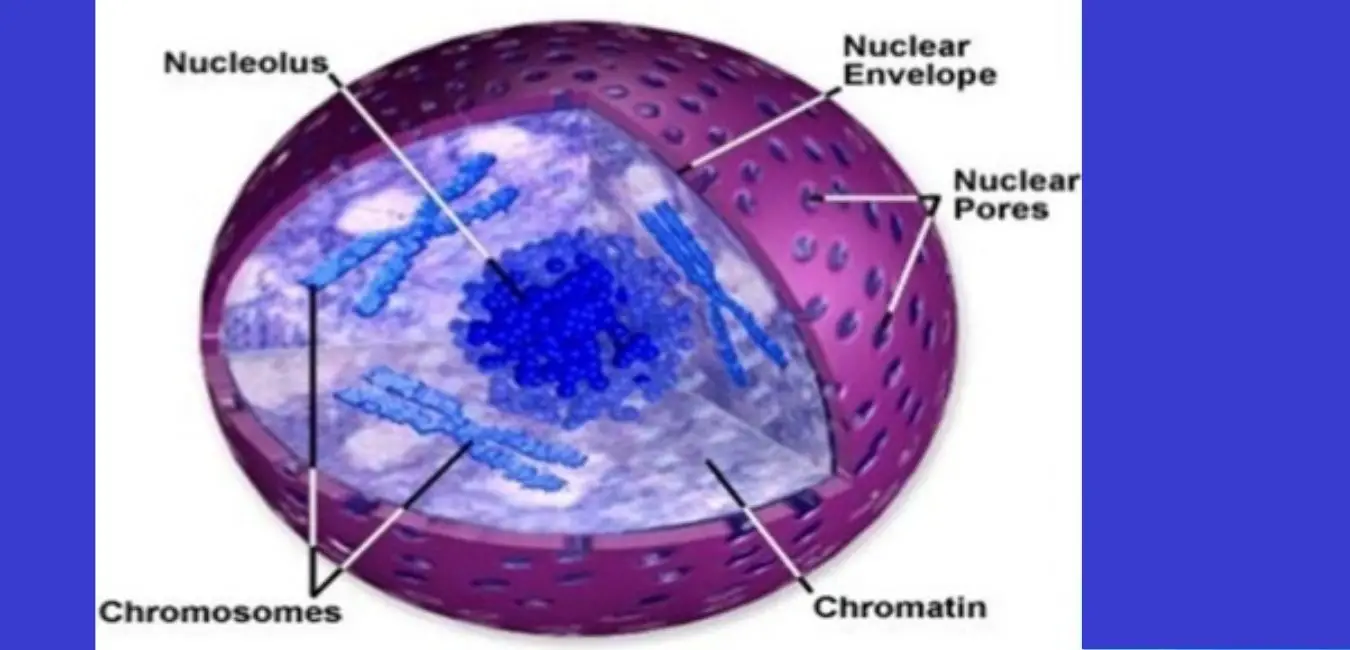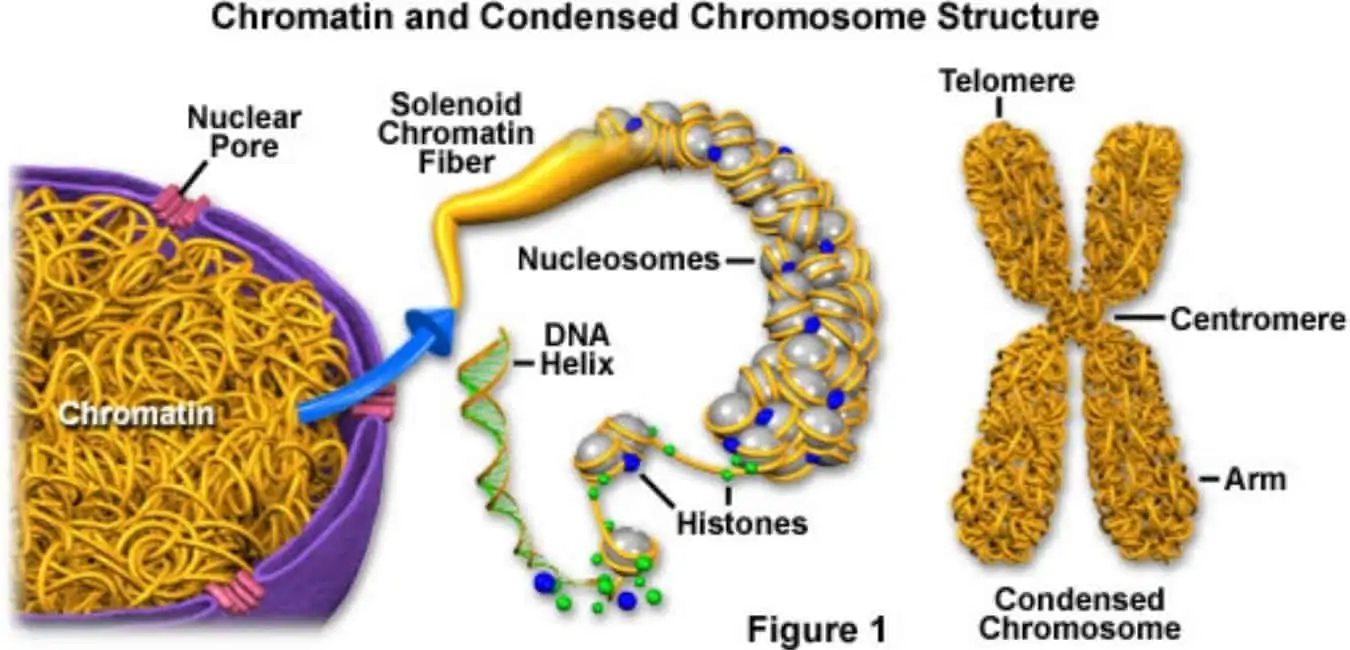Welcome back, friends. Today we are digging some academics just for fun and of course for understanding. We will discuss Parts of the Plant cell: Chromatin. Get ready to Learn Everything about Chromatin In-Plant cell. If you are new to the blog then you must check out 10 Important Functions of Vacuoles in Plant Cell.

Ok, let’s start…
What Is Chromatin?
Chromatin is a complex string-like molecule inside a cell. It is composed of proteins arranged in a bead-like structure with genetic materials. The primary protein in Chromatin is Histones. These proteins help in condensation or simply compression of DNA and RNA strands as Chromosomes.
Histones arrange the DNA strands in a specific order with extreme nuclear compression. The bead-like structure in which the DNA is arranged is called the Nucleosomes.
The nucleosomes formed after protein binding compress the DNA strands to 1/6th of their length.
Further, it can coil and compress the genetic Strands of DNA and RNA down to 1/40th of its actual size.
Overall the DNA package is compressed by Histone to a factor of 240. You can compare this as if a full-grown adult has fit inside a chicken egg.
The Compression and the precision of DNA arrangement inside a cell are extraordinary.
Chromatin is a positively charged macromolecule due to the presence of histones. It equates and neutralized the opposite charge of DNA composed in Nucleosomes. Therefore, keeping the Nucleus electrically neutral.
Usually, the DNA moves toward an inaccessible location after compression. It will remain inert in isolated space for future use by the cell. In this state, the condensed DNA has no direct participation in any Cellular life processes.
Types of Chromatin in Plant cell
Plant cell Chromatin is of two types. The first is Euchromatin and another one is Heterochromatin.
Euchromatin is the genetically active part of the chromatin. It is responsible for transcribing RNA to produce the Proteins necessary for cell function and growth. In simple words, Euchromatin is responsible for most of the cellular life processes. It decides the state, Patter, and development cycle of the cell.
Heterochromatin is the dense inactive portion of chromatin. It consists mostly of inactive DNA. Heterochromatin is the isolated place to store genetic information for the next generations.
It doesn’t participate in any cellular functions or its life growth support. Instead, it contains the DNA in inactive form for further sharing of genetic traits and characteristics. These inactive DNA initiate the cellular division of the nucleus and relevant core genetic materials.
Does a Plant cell have Chromatin?
Yes, definitely every Plant cell has Chromatin. It is the key component to transcribe the RNA or DNA. In simple words, we can say that chromatin contains the necessary information about the life cycle of every cell.
A plant cell has unique Chromatin structures specific to different plant species. Therefore, you can find both compressed and uncompressed Nucleosomes with specific plant species.
Every plant variety must have a chromatin structure whether it is big or small, thin or thick. Chromatin is always located inside the nucleus of the plant cell.
Where is Chromatin Found in Plant Cell?

Chromatin is present in the Nucleus of the Plant cell. It is a string-like fibrous macromolecular structure of Chromosomes that defines the genetic material DNA. It is always present inside the nucleus of the cell.
Chromatin contains several proteins, Histone is the important one to know. Histone helps in binding and packaging of Chromaine fibers into dense Spiral spring-like structures. The DNA and RNA molecules are embedded in this structure like a bead in a tread. This bead-like structure is called Nucleosomes.
All of these structures reside inside the nucleus of the cell.
Do plants have lysosomes? Everything to Know
What does chromatin look like in plant cells?
Chromatins are dense thread or string-like structures arranged in a specific order inside the nucleus of every cell.
The chromatin looks like a coiled spring with tiny beads studied in it. The structure of chromatin is not very easy to observe even with an electron microscope.
It has a very dense structure with interconnected portions. These portions are basically the types of chromatin with a specific purpose inside a plant cell.
The condensation of Chromatin fiber looks different according to different plant species. Sometimes it becomes very difficult to distinguish the difference between Euchromatin and Heterochromatin with the condensed state.
Chromatin picture in Plant cell
Chromatin is present inside every Plant or Animal cell. In a plant cell, we can identify two specific types of Chromatin- Euchromatin, and Heterochromatin.
Although these molecules are so tiny that you will need a powerful electron microscope to observe them.
Read more about: How to Remove a Sago Palm?- Easy Step Guide
The function of Chromatin in Plant cell
The main function of Chromatin is to compress and arrange the DNA molecules in a compact state inside the nucleus.
Chromatin is a composed and folded structure formed by nucleosomes. The nucleosome is a dense package of DNA strands. Proteins especially histone is responsible for the compression of DNA and RNA molecules.
The DNA strands or molecules are arranged in a bead-like structure in the nucleosome.
Further compression of nucleosome by twisting and coiling it with a factor of 40 makes the chromatin fiber. This structure is so compact that it becomes difficult to distinguish the strands separately.
You can easily understand this with human DNA. Our DNA Contains 46 individual molecules. One for each Chromosome. Each of these molecules has a length of 1.5 inches. Collectively the overall length of human DNA is 6 feet. Now, it is the responsibility of Chromatin to compress this long DNA strand inside a microscopic cell. Isn’t it interesting?
Therefore, Chromatin plays a crucial role in the compression and storage of genetic material inside a cell.
Conclusion
The Chromatin fiber is a compact dense macroscopic structure inside every Plant cell. It contains DNA and RNA in a compressed state.
Therefore, it is an important part of plant or animal cells to study. That’s why I always ask everyone to Keep Reading and Keep Gardening!
Reference: https://micro.magnet.fsu.edu/cells/plants/nucleus.html

